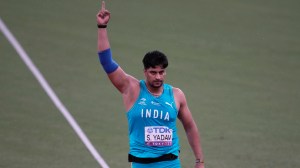Sri Lanka’s ups and downs at the World Cup
When India play Sri Lanka tomorrow, they will take on a team that shares more than boundaries — both countries place the burden of mass...

When India play Sri Lanka tomorrow, they will take on a team that shares more than boundaries — both countries place the burden of massive public pressure on their players and both suffer the stigma of politicisation of cricket.
And, perhaps, both sides can be faulted for over-dependence on two star batsmen, Tendulkar and Jayasuriya.
Sri Lanka have taken a beating in the runup to this tournament, but have been winning on the wings of Jayasuriya’s dramatic return to form. If the relentless advertisements and patriotic publicity have given the Indian public an exaggerated sense of the team’s chances, Sri Lankan fans have had extremely modest expectations.
Until a fortnight ago, no one gave Sri Lanka a realistic hope of reaching the Super Sixes. Today, even the world cup final isn’t out of the question — but standing in the way is that old rival.
Yet of all the participants in the 2003 World Cup, Sri Lanka has the most capricious record. They have lost more World Cup matches since the tournament’s inception in 1975 than anyone else, but have also reached dizzying heights such as the memorable, rags-to-riches triumph in 1996.
For an itinerant fan of Sri Lankan cricket, following the World Cup has been a cathartic and emotional affair. It must be recalled that India has played a part in Sri Lanka’s bid for test status.
Sri Lanka’s victory over Venkatraghavan’s India in the 1979 World Cup, strengthened Sri Lanka’s case for test status. One remembers the heavy expectations with which Sri Lanka approached the 1983 World Cup, the first time they had participated in the tournament as a full member of the ICC. The legendary Gary Sobers was then the coach of a Sri Lankan team laden with attacking batsmen and capable seam bowlers.
After pre-tournament victories over Kim Hughes’s Australians, Sobers raised hopes by boldly proclaiming that Sri Lanka would make the semi-finals. The 1983 tournament will always be remembered for India’s upset victory, and Sri Lanka’s spirited performance went almost unnoticed.
With batsmen such as the exceptionally elegant Roy Dias, the agricultural Duleep Mendis and emerging stars such as Ranjan Madugalle and Arjuna Ranatunga, Sri Lanka had the depth and firepower to chase challenging totals. Ashantha de Mel, a seamer with a Lillee-esque sideways-on action, became the tournament’s highest wicket-taker, along with India’s Roger Binny, though De Mel’s 18-wicket haul was in six matches, while Binny’s took eight.
The 1987 edition was clearly the most forgettable experience that Sri Lanka has had in international cricket. Playing most of their matches in Pakistan, Sri Lanka failed to win any, making them the worst team in the tournament, even behind associate member Zimbabwe. The islanders looked rusty and haggard, with the old firm of Mendis and Dias looking out of place in international cricket.
The team’s isolation from international cricket had stagnated the careers of players such as Ranatunga, Madugalle, Aravinda de Silva and Ravi Ratnayake. The team’s ignominy was complete when a rampant Viv Richards carved out a brutal 181 in Lahore. Predictably, Mendis resigned from the captaincy and slowly faded into cricketing oblivion.
In 1992, Sri Lanka was still too untested and isolated from international cricket to make an impression on the tournament. Too add to their woes, they were burdened with a gruelling travel schedule in the Antipodes and a reluctant captain in Aravinda de Silva.
The 25-year-old Aravinda was installed as captain due to political opposition to Arjuna Ranatunga, whose father was an opposition Member of Parliament. Despite the team’s two wins against Zimbabwe and South Africa, there was never any question about the class of Ranatunga and de Silva, the two players who would lead the side to victory in 1996. These two batsmen formed the experienced core of the team, in much the same way that Imran Khan and Javed Miandad did for Pakistan in 1992.
These two, in fact, were at the crease when the winning runs were hit in that 1996 final in Lahore. Ranatunga’s leadership and de Silva’s batting brilliance had as much to do with the triumph, as the pinch-hitting of Jayasuriya and Kaluwitharana.
En route to the memorable win in 1996, Sri Lanka outplayed India in the league match in Delhi, with Jayasuriya batting for the sheer joy of hitting the cricket ball. If there was a sour note to their win, it was the crowd violence which brought a premature end to the semi-final against India at Eden Gardens.
India’s revenge in 1999 was comprehensive. At Taunton, the county ground which was once home to fabled big-hitters such as Viv Richards and Ian Botham, Saurav Ganguly essayed a murderous assault on Sri Lanka’s bowlers, his 188 sealing the match and the defending champion’s fate in the tournament.
(The writer is an editor of Colombo-based website thewicket.com)
Photos



- 01
- 02
- 03
- 04
- 05




























